Invisible-ink-assisted pattern and written surface-enhanced Raman scattering substrates for versatile chem/biosensing platforms†
Abstract
In recent years, highly sensitive surface-enhanced Raman scattering (SERS) integrated with flexible substrates has drawn increasing attention for label-free detection. In this study, an invisible ink-inspired process was developed for the fabrication of plasmonic Au-based SERS substrates through an on-site redox strategy. Tannic acid (TNA), a common green reagent, was used not only for fabricating various SERS absorbents through a confinement reduction of a Au-TNA complex, but also for supplying an amphiphilic inorganic–organic surface structure for outstanding SERS enhancement at micromolar to nanomolar concentrations for a wide range of compounds. In addition to label-free sensing, this TNA/Au-based SERS substrate provides a versatile analysis platform for studies of chemical and biological reactions. A combination of TNA ink with different metal ions allows for a reliable procedure for the synthesis of a bimetallic AuAg SERS substrate that further enhances the SERS intensity of analyte molecules and extends the lower limit of detection.



 Please wait while we load your content...
Please wait while we load your content...